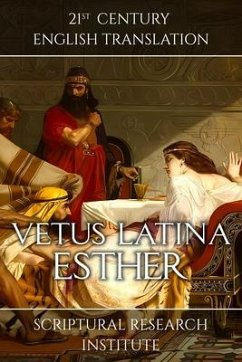The Vetus Latina is a collection of Latin language translations of the ancient Israelite texts, mainly based on the Greek language Septuagint translation. Not all of the Vetus Latina books were translated from the Septuagint though, as some were translated from versions of the ancient texts that do not otherwise survive to the present. The Vetus Latina's version of Esther is one of the books not translated from either the Septuagint or proto-Masoretic versions of Esther, and therefore, is the fourth primary source for the Book of Esther. The Vetus Latina, which translates as 'Old Latin,' were the texts in use in the Latin-speaking regions of the Roman Empire, prior to the Orthodox Church ordering an official translation into Latin, which was created by Jerome, between 382 and 405 AD.
The settling of the book is also an issue that has been debated over the centuries. The king in the story is called Artaxerxes in the Vaticanus and Vetus Latina versions, but Ahasuerus in the Masoretic and Alpha versions of the book. The name Ahasuerus is not the proper translation of Artaxerxes, but of Xerxes, and most modern scholars believe the classical translation of Artaxerxes was an error.
There are many indicators in the story, that point to it being set in the era of Xerxes I, the first of which is the reference to him calling all the satraps (governors) of Persia to the capital of Susa in his third year. Both the Vaticanus and Masoretic versions of Esther agree that it was the third year, while the Vetus Latina reports it was in the twelfth year. As the years in the Vetus Latina are out of order, as the events in the seventh year follow the events of the twelfth, the chronology of the Vetus Latina is suspect, and therefore most scholars accept that the original year referenced by the author was regal year 3 of the king's reign. In the case of Xerxes I, this was 483 BC, when Xerxes did call his satraps to Susa to plan the invasion of Greece.
The settling of the book is also an issue that has been debated over the centuries. The king in the story is called Artaxerxes in the Vaticanus and Vetus Latina versions, but Ahasuerus in the Masoretic and Alpha versions of the book. The name Ahasuerus is not the proper translation of Artaxerxes, but of Xerxes, and most modern scholars believe the classical translation of Artaxerxes was an error.
There are many indicators in the story, that point to it being set in the era of Xerxes I, the first of which is the reference to him calling all the satraps (governors) of Persia to the capital of Susa in his third year. Both the Vaticanus and Masoretic versions of Esther agree that it was the third year, while the Vetus Latina reports it was in the twelfth year. As the years in the Vetus Latina are out of order, as the events in the seventh year follow the events of the twelfth, the chronology of the Vetus Latina is suspect, and therefore most scholars accept that the original year referenced by the author was regal year 3 of the king's reign. In the case of Xerxes I, this was 483 BC, when Xerxes did call his satraps to Susa to plan the invasion of Greece.
Dieser Download kann aus rechtlichen Gründen nur mit Rechnungsadresse in A, D ausgeliefert werden.









